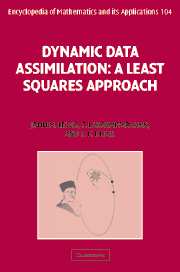Book contents
- Frontmatter
- Contents
- Preface
- Acknowledgements
- PART 1 GENESIS OF DATA ASSIMILATION
- 1 Synopsis
- 2 Pathways into data assimilation: illustrative examples
- 3 Applications
- 4 Brief history of data assimilation
- PART II DATA ASSIMILATION: DETERMINISTIC/STATIC MODELS
- PART III COMPUTATIONAL TECHNIQUES
- PART IV STATISTICAL ESTIMATION
- PART V DATA ASSIMILATION: STOCHASTIC/STATIC MODELS
- PART VI DATA ASSIMILATION: DETERMINISTIC/DYNAMIC MODELS
- PART VII DATA ASSIMILATION: STOCHASTIC/DYNAMIC MODELS
- PART VIII PREDICTABILITY
- Epilogue
- References
- Index
4 - Brief history of data assimilation
from PART 1 - GENESIS OF DATA ASSIMILATION
Published online by Cambridge University Press: 18 December 2009
- Frontmatter
- Contents
- Preface
- Acknowledgements
- PART 1 GENESIS OF DATA ASSIMILATION
- 1 Synopsis
- 2 Pathways into data assimilation: illustrative examples
- 3 Applications
- 4 Brief history of data assimilation
- PART II DATA ASSIMILATION: DETERMINISTIC/STATIC MODELS
- PART III COMPUTATIONAL TECHNIQUES
- PART IV STATISTICAL ESTIMATION
- PART V DATA ASSIMILATION: STOCHASTIC/STATIC MODELS
- PART VI DATA ASSIMILATION: DETERMINISTIC/DYNAMIC MODELS
- PART VII DATA ASSIMILATION: STOCHASTIC/DYNAMIC MODELS
- PART VIII PREDICTABILITY
- Epilogue
- References
- Index
Summary
In this chapter we provide an overview of the historical developments that led to the vast and rich discipline called dynamic data assimilation.
Where do we begin the history?
In Chapters 1 and 2 we have established our philosophy of dynamic data assimilation. Central to this philosophy is the existence of data and governing equations or model dynamics. Thus, the Herculean efforts by scientists like Galileo and Kepler and Newton, efforts that made use of observations to formulate theory, fall outside our scope. Their monumental contributions established some of the governing equations (also known as constraints) upon which dynamic data assimilation depends.
The mathematicians and astronomers of the seventeenth and eighteenth centuries who made use of the Newtonian laws to calculate the orbits of comets were the first data assimilators in our sense of the definition. Newton was among them and he discussed the problem in Principia (Book III, Prop. XLI). Regarding the problem of determining the orbit of comets, he said: “This being a problem of very great difficulty, I tried many methods of resolving it.” Among the early investigators of this problem were Leonard Euler, Louis Lagrange, Pierre-Simon Laplace, and lesser known amateur astronomers like Heinrich Olbers. The task of finding the path of a comet, of course, relied on the coupled set of nonlinear differential equations that described its path under the assumption of two-body celestial mechanics – the motion controlled by the gravitational attraction of the comet to the Sun.
- Type
- Chapter
- Information
- Dynamic Data AssimilationA Least Squares Approach, pp. 81 - 96Publisher: Cambridge University PressPrint publication year: 2006



